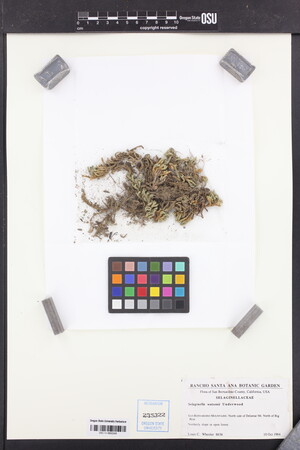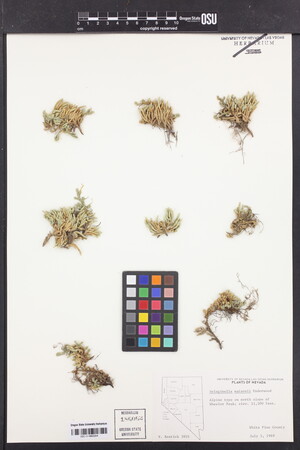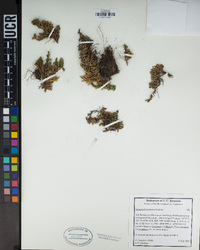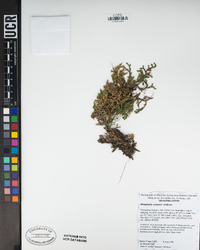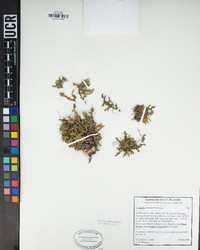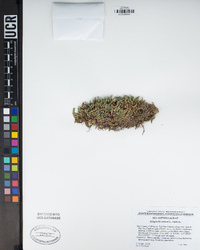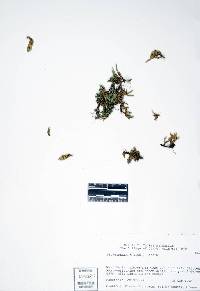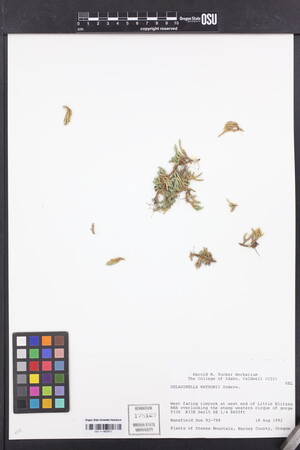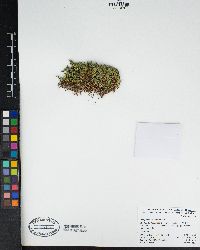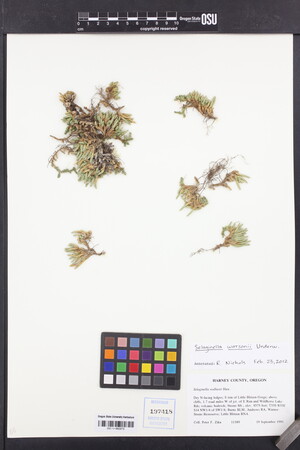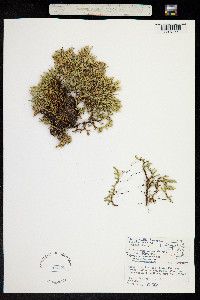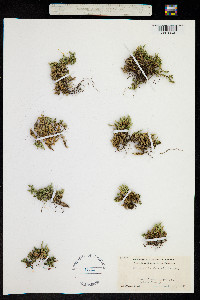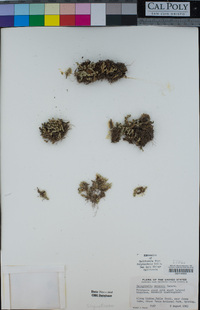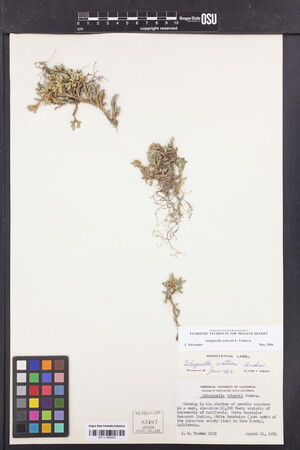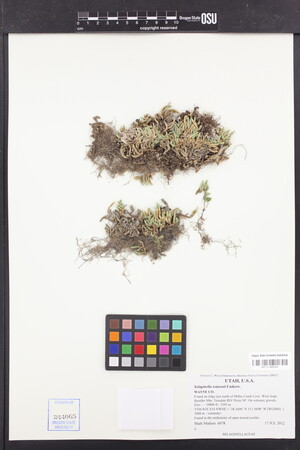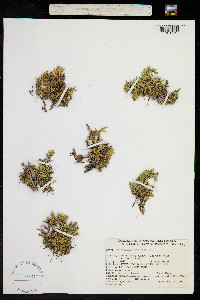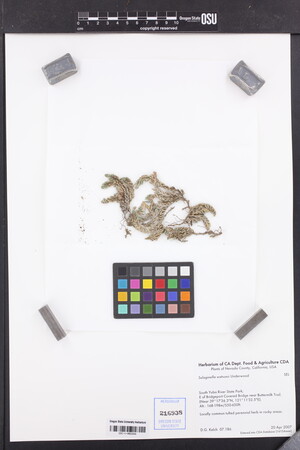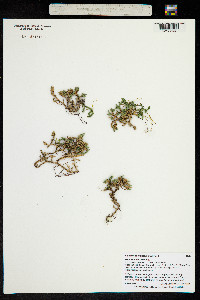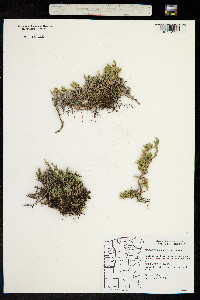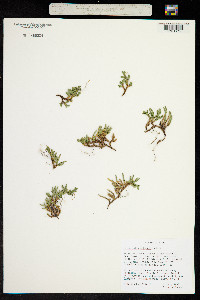Selaginella watsonii
|
|
|
|
Family: Selaginellaceae
Watson's Spike-Moss, more...Watson's spikemoss, alpine spikemoss
[Bryodesma watsonii (Underw.) Soják] |
Plants on rock or terrestrial, forming long or compact cushionlike mats. Stems radially symmetric, decumbent to long-creeping, not readily fragmenting, irregularly forked, without budlike arrested branches, tips straight; main stem conspicuously determinate, lateral branches conspicuously or inconspicuously determinate, strongly ascending, 1--3-forked. Rhizophores borne on upperside of stems, throughout stem length, 0.35--0.55 mm diam. Leaves monomorphic, in alternate pseudowhorls of 4, tightly or loosely appressed, ascending, green, linear-lanceolate, (2.5--)3--4 X 0.5--0.7 mm; abaxial ridges prominent; base cuneate, decurrent, glabrous or sometimes pubescent; margins entire or short-ciliate, cilia transparent, scattered, spreading, 0.05--0.1 mm; apex strongly keeled, obtuse, abruptly bristled; bristle whitish to transparent, smooth, 0.25--0.5 mm. Strobili solitary, 0.5--3(--3.5) cm; sporophylls lanceolate to ovate-lanceolate, abaxial ridges well defined, base glabrous, margins entire, rarely dentate, apex strongly keeled to truncate in profile, short-bristled. On exposed or shaded cliffs, rocky slopes, rock crevices, granite boulders, quartzite rock, gravelly or sandy soil, alpine meadows, or swampy grounds; 1800--4300 m; Ariz., Calif., Idaho, Mont., Nev., Oreg., Utah, Wyo. R. M. Tryon (1955) suggested that Selaginella watsonii is a possible ancestor of (or shares a common ancestor with) S . leucobryoides , S . asprella , and S . utahensis (see discussion).
STEMS: monomorphic, prostrate, not readily fragmenting when dry, the branch tips appearing straight when dry, forming dense usually cushion-like mats. RHIZOPHORES: produced throughout. LEAVES: monomorphic, 2.5-4.0 mm long, narrowly lanceolate, green to yellowish green when hydrated, the base more or less decurrent (similar in color to the stem) and more or less symmetrically narrowed, the tip with a straight or somewhat curved white seta 0.2-0.5 mm long (sometimes breaking off with age), the margins entire, denticulate, or short-ciliate. STROBILI: 5-30 mm long, the sporophylls lanceolate to broadly lanceolate, narrowed to an acute tip with a short seta, the margins entire or denticulate. MEGASPORES: finely rugose to rugose-reticulate, orange. NOTES: Rock outcrops, ledges, boulders, cliffs, and rarely on open gravelly slopes, on igneous and volcanic substrates and sandstone: Coconino, Mohave cos. (Fig. 1H); 2400-2550 m (7850-8400 ft); e WA s to e CA, e to MT and AZ. REFERENCES: Yatskievych, G. and M. D. Windham. Vascular Plants of Arizona: Selaginellaceae. CANOTIA 5 (1): 39-48, 2009. Yatskievych and Windham 2009 Common Name: Watson's Spikemoss Wetland Status: None Leaves: Monomorphic, 2.5-4 mm long, narrowly lanceolate, green to yellowish green when hydrated, the base more or less decurrent (similar in color to the stem) and more or less symmetrically narrowed, the tip with a straight or somewhat curved white seta 0.2-0.5 mm long (sometimes breaking off with age), the margins entire, denticulate, or short-ciliate. Sporangia: Strobili 5-30 mm long, the sporophylls lanceolate to broadly lanceolate, narrowed to an acute tip with a short seta, the margins entire or denticulate. Megaspores finely rugose to rugose-reticulate, orange. Ecology: Found on rock outcrops, ledges, boulders, cliffs, and rarely on open gravelly slopes, on igneous and volcanic substrates and sandstone from 7,500-8,500 ft (2286-2591 m). Notes: Similar to S. leucobryoides which overlaps in range in the Mojave desert, but is distinguished by S. leucobryoides having dry stems that readily fragment. Ethnobotany: Unknown Etymology: Selaginella is a diminutive of Selago, the name of another similar plant, while watsonii is named for the American botanist Sereno Watson. Synonyms: None Editor: SBuckley 2013 |







